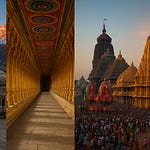The month of Shravan, also known as Sawan, marks a spiritually charged period in the Hindu lunar calendar dedicated solely to the worship of Lord Shiva. Occurring during the monsoon season, Shravan is considered one of the holiest months, drawing millions of devotees into deep devotion, fasting, and spiritual journeys to sacred Shiva shrines across India.
This article explores the essence of Shravan, the unique rituals at Kashi Vishwanath Dham, and divine pilgrimages to Jyotirlingas like Mahakaleshwar (Ujjain), Omkareshwar, Trimbakeshwar, Kedarnath, and Somnath.
🕉️ Significance of Shravan Month
According to Hindu mythology, during the Samudra Manthan (cosmic churning of the ocean), a deadly poison called Halahala emerged that threatened to destroy creation. Lord Shiva, in his boundless compassion, consumed the poison to protect the universe, holding it in his throat, which turned blue—earning him the name Neelkanth.
To honor this supreme sacrifice, devotees dedicate the month of Shravan to Lord Shiva. Shravan Somwars—the Mondays of this month—are especially sacred, with devotees observing fasts, offering milk, bel leaves, and water to Shiva Lingams. These acts symbolize surrender, penance, and the desire for spiritual awakening.
🙏 Kashi Vishwanath Dham: The Heart of Shravan Devotion
Located in the eternal city of Varanasi, Kashi Vishwanath Temple is among the twelve Jyotirlingas—the holiest abodes of Lord Shiva. Shravan transforms Kashi into a spiritual epicenter. Devotees from every corner of the country converge to seek blessings at this sacred temple, believed to grant liberation from the cycle of life and death.
The air resonates with the chant of “Har Har Mahadev”, as priests conduct powerful rituals and adorations (Shringars) throughout the month. Each Monday of Shravan is marked by a different symbolic adornment of Lord Shiva, representing his various divine forms:
First Monday: The movable idol is beautifully decorated
Second Monday: The Gauri-Shankar Shringar honors the union of Shiva and Parvati
Third Monday: The Ardhanarishwar Shringar represents the duality of divine masculine and feminine energies
Fourth Monday: Rudraksh Shringar showcases Shiva's meditative and ascetic form
Full Moon (Purnima): The Jhula Shringar depicts Shiva seated on a ceremonial swing, celebrating divine joy
Throughout the month, devotees witness sacred Mangala Aarti, Shringar Aarti, Bhog Aarti, Saptarishi Aarti, and Shayan Aarti, immersing themselves in the vibrations of devotion.
🔱 Ujjain Mahakaleshwar Darshan During Shravan
A major highlight of Shravan pilgrimage is the visit to Mahakaleshwar Temple in Ujjain, Madhya Pradesh—another revered Jyotirlinga. The temple is known for the Bhasma Aarti, a pre-dawn ritual where the deity is bathed in sacred ash (bhasma), signifying the transient nature of life.
During Shravan, the Mahakaleshwar Temple becomes a center of intense devotional activity. The spiritual energy is elevated by continuous chants, Rudrabhishek rituals, and processions of the deity through the city. Devotees line up through the night for a glimpse of the Bhasma Aarti, an experience said to awaken deep inner consciousness.
The temple’s proximity to the Kshipra River, another spiritual landmark, adds to the sanctity of the pilgrimage.
🛕 Other Sacred Jyotirlingas to Visit During Shravan
While Kashi Vishwanath and Mahakaleshwar hold a special place during Shravan, devotees often extend their pilgrimage to other powerful Jyotirlingas that represent Shiva’s omnipresence across India.
1. Omkareshwar Jyotirlinga – Madhya Pradesh
Situated on an island shaped like the sacred syllable 'ॐ' in the Narmada River, Omkareshwar is a deeply mystical Jyotirlinga site. During Shravan, the temple witnesses a surge in spiritual seekers, and special Abhishekam rituals are performed. The island itself is considered a natural yantra of divine vibrations.
2. Trimbakeshwar Jyotirlinga – Nashik, Maharashtra
Located at the origin of the holy Godavari River, Trimbakeshwar holds immense significance. The unique feature of this temple is the presence of three lingas representing Brahma, Vishnu, and Shiva. Shravan is an especially auspicious time to visit, with traditional rituals like Kalsarpa Dosha Puja, Maha Mrityunjaya Jaap, and elaborate Abhishekams conducted by Vedic priests.
The town of Trimbak and the nearby Brahmagiri hills add spiritual charm, as this area is revered for its ascetic lineage and cosmic energies.
3. Kedarnath Jyotirlinga – Uttarakhand
Tucked high in the Himalayas, Kedarnath is among the most revered Shiva shrines. Accessible only during specific months due to snowfall, the temple sees a significant inflow of pilgrims during Shravan. The trek to Kedarnath, amid serene valleys and snow-capped peaks, is not just a physical journey but a test of inner devotion and faith.
The experience of offering prayers in the lap of the Himalayas, with bells echoing in the silence, creates a powerful spiritual impact.
4. Somnath Jyotirlinga – Gujarat
Known as the first among the 12 Jyotirlingas, Somnath stands along the Arabian Sea, a symbol of timeless divinity and destruction-defying resilience. During Shravan, the temple hosts grand Aartis and spiritual discourses. Devotees often combine the darshan with meditation near the ocean, creating a tranquil environment for reflection and surrender.
📿 Essence of the Pilgrimage Experience
Embarking on a Shravan Yatra is not merely about visiting temples—it is a transformational journey. Each Jyotirlinga radiates a unique aspect of Lord Shiva’s divine energy:
Kashi brings liberation
Ujjain invokes cosmic destruction and rebirth
Omkareshwar fosters meditative balance
Trimbakeshwar harmonizes the trinity
Kedarnath leads to inner stillness
Somnath celebrates the eternal
The convergence of spiritual discipline, ritual immersion, and natural beauty during Shravan helps devotees align with Shiva’s infinite grace.
🧘 Practical Guidance for Pilgrims
Plan in advance due to large crowds and accommodation constraints
Follow temple guidelines strictly, especially regarding prohibited items and dress codes
Stay hydrated and nourished, especially during fasts and treks
Travel with intention, not just as tourists but as seekers
Participate actively in the rituals to gain spiritual merit
Respect local customs and maintain the sanctity of sacred spaces
Shravan is a month of divine opportunity. Whether through intense fasting, quiet meditation, ritual offerings, or pilgrimages to holy sites, devotees open their hearts to Lord Shiva’s presence.
Pilgrimages to Kashi Vishwanath, Mahakaleshwar, Trimbakeshwar, Omkareshwar, Kedarnath, and Somnath are not just travels—they are spiritual transformations. The sacred journey through these Jyotirlingas during Shravan offers a chance to reconnect with the eternal truth, awaken inner peace, and seek blessings for this life and beyond.
Let this Shravan be the time when one walks not just on holy soil—but toward liberation, surrender, and divine consciousness.
Har Har Mahadev. 🔱











